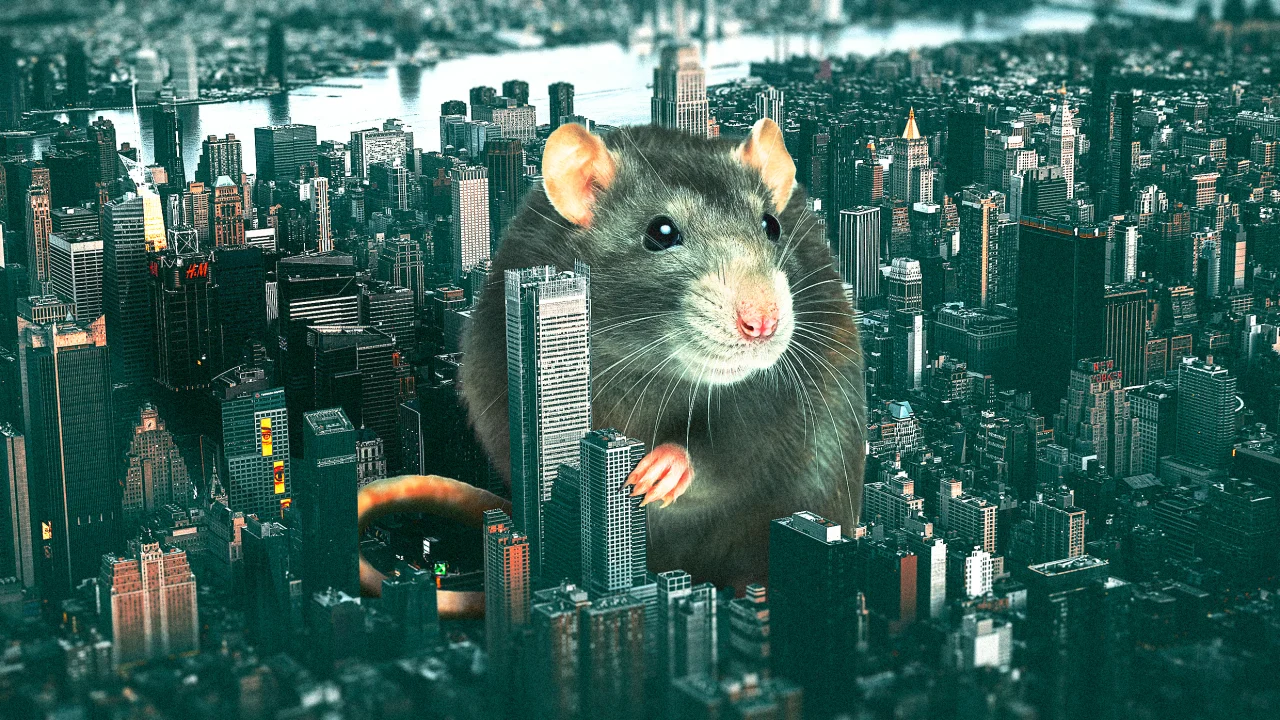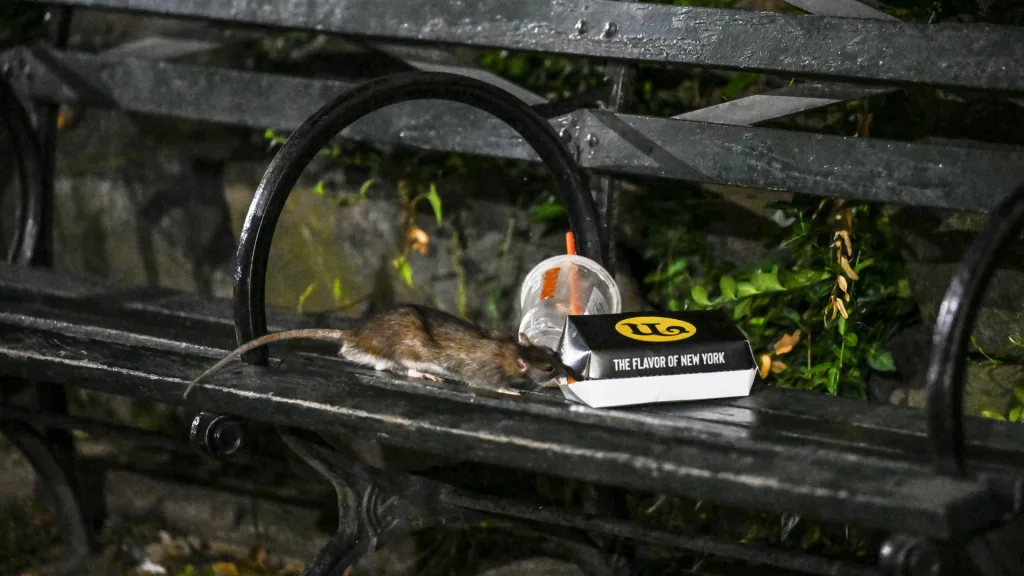NYC will never win its war on rats, so it’s settling for a truce
On a bright morning in mid-August a group of New Yorkers formed a circle in Collect Pond Park, a small public space in Lower Manhattan that, for its size, has an unusually robust population of rodents. (It has been described as an unofficial rat zoo.) We were here to meet Kathy Corradi, New York’s first-ever rat czar—or in administrative parlance, the citywide director of rodent mitigation—on a guided walk to better understand the relationship between these creatures, our city, and ourselves. “They’re just like us,” Corradi tells us as she bounds into a planter, pushes aside long stalks of milkweed, and points out the entrance to a burrow. “They want to live in a nice place, have food nearby, and not get into too much trouble if they can.” Ah, the New York City Rat. Rattus norvegicus, or the Norway Rat as the species is named. It’s a creature of myth and legend anointed into sainthood by way of viral videos, turned into a hero thanks to a cartoon about mutant turtles, and mused about by many generations of writers. “Anyone who has been confronted by a rat in the bleakness of a Manhattan dawn and has seen it whirl and slink away, its claws rasping against the pavement, thereafter understands fully why this beast has been for centuries a symbol of the Judas and the stool pigeon, of soullessness in general,” described the great chronicler of New York City, Joseph Mitchell, in a 1944 New Yorker article. These rodents have burrowed and gnawed their way into our culture to become as emblematic of the city as the Yankees, as a stunt rebrand of its minor league affiliate into the Staten Island Pizza Rats in 2018 reminded us. (The big league was not impressed.) But they’re a menace that the city can’t seem to shake. When the city’s Sanitation Commissioner Jessica Tish said “the rats don’t run this city, we do,” during an announcement of new rat-busting rules for waste collection, it sounded more like a coach’s pep talk five minutes before her team gets obliterated by their opponent—in the city’s case, an untold number of brown, hairy, four-legged animals that can squeeze their way into any opening the size of a quarter or larger. The collective coping mechanisms (memes, jokes, and arch soundbites from politicians) make light of the fact that rats are making people sick and they’re a public health hazard. Last year saw the highest rates of leptospirosis, a bacterial infection spread through rat urine that can cause organ failure and death, and rat sightings are spiking. While much about the city has changed in the 80 years since Mitchell penned his essay, the core problem hasn’t: there are simply too many of these creatures among us. But now, New York is betting that new innovations in rat control will finally reign in the problem. It’s leaning on evidence-based approaches and a philosophy of integrated pest management (meaning the use of multiple methods to address the underlying conditions that enable rats to thrive) to tackle the issue. Among them are rat birth control, the containerization of waste, and a public education campaign called the Rat Pack, which includes the rat walk that I attended. “I like to say, city and citizens need to take action,” Corradi later told me. “New Yorkers have this fear and fascination with rats. How do we bridge that fascination into empowerment and action?” [Photo: Katie Dobies/Getty Images] Useless mitigation efforts As the rat walkers meandered through the park, Corradi showed us a rat’s-eye view of the city: the soil in which this burrowing creature likes to make a home; the bagel chunks and glistening, flaccid pepperoni on the pavement it could eat; and the pond where it could find water. It turns out that as humans built New York City, it also built a perfect place for rodents. A third of the city is built atop easy-to-dig-through infill. Coupled with the old brick catch basins constructed before concrete was the norm and the density of buildings, the city is a uniquely hospitable place for rats. “The Swiss cheese beneath us? You couldn’t design it better for the Norway rat,” Corradi told the group. Even the ubiquitous black bait boxes that were in the park somehow benefitted its community of rats. The animals, which can survive on as little as one ounce of food a day (which could come from grease slicks left where trash bags accumulate) don’t like trying new food sources and rarely take the bait. Rats have their regular restaurants, too. The Department of Health regularly sees the holes plugged up with paper and other detritus from enterprising rats who’ve decided to make the boxes their home. As Corradi tells us this, a rat scurried from behind the group and nosedived into a burrow right behind her—a horrifying celebrity sighting. New York City’s first “rat czar”, Kathleen Corradi. [Photo: Selcuk Acar/Anadolu Agency/Getty Images] As Corradi explained this, I thought of all the useless bait boxes that appeared around my apa

On a bright morning in mid-August a group of New Yorkers formed a circle in Collect Pond Park, a small public space in Lower Manhattan that, for its size, has an unusually robust population of rodents. (It has been described as an unofficial rat zoo.) We were here to meet Kathy Corradi, New York’s first-ever rat czar—or in administrative parlance, the citywide director of rodent mitigation—on a guided walk to better understand the relationship between these creatures, our city, and ourselves.
“They’re just like us,” Corradi tells us as she bounds into a planter, pushes aside long stalks of milkweed, and points out the entrance to a burrow. “They want to live in a nice place, have food nearby, and not get into too much trouble if they can.”
Ah, the New York City Rat. Rattus norvegicus, or the Norway Rat as the species is named. It’s a creature of myth and legend anointed into sainthood by way of viral videos, turned into a hero thanks to a cartoon about mutant turtles, and mused about by many generations of writers.
“Anyone who has been confronted by a rat in the bleakness of a Manhattan dawn and has seen it whirl and slink away, its claws rasping against the pavement, thereafter understands fully why this beast has been for centuries a symbol of the Judas and the stool pigeon, of soullessness in general,” described the great chronicler of New York City, Joseph Mitchell, in a 1944 New Yorker article.
These rodents have burrowed and gnawed their way into our culture to become as emblematic of the city as the Yankees, as a stunt rebrand of its minor league affiliate into the Staten Island Pizza Rats in 2018 reminded us. (The big league was not impressed.) But they’re a menace that the city can’t seem to shake.
When the city’s Sanitation Commissioner Jessica Tish said “the rats don’t run this city, we do,” during an announcement of new rat-busting rules for waste collection, it sounded more like a coach’s pep talk five minutes before her team gets obliterated by their opponent—in the city’s case, an untold number of brown, hairy, four-legged animals that can squeeze their way into any opening the size of a quarter or larger.
The collective coping mechanisms (memes, jokes, and arch soundbites from politicians) make light of the fact that rats are making people sick and they’re a public health hazard. Last year saw the highest rates of leptospirosis, a bacterial infection spread through rat urine that can cause organ failure and death, and rat sightings are spiking.
While much about the city has changed in the 80 years since Mitchell penned his essay, the core problem hasn’t: there are simply too many of these creatures among us. But now, New York is betting that new innovations in rat control will finally reign in the problem. It’s leaning on evidence-based approaches and a philosophy of integrated pest management (meaning the use of multiple methods to address the underlying conditions that enable rats to thrive) to tackle the issue. Among them are rat birth control, the containerization of waste, and a public education campaign called the Rat Pack, which includes the rat walk that I attended. “I like to say, city and citizens need to take action,” Corradi later told me. “New Yorkers have this fear and fascination with rats. How do we bridge that fascination into empowerment and action?”

Useless mitigation efforts
As the rat walkers meandered through the park, Corradi showed us a rat’s-eye view of the city: the soil in which this burrowing creature likes to make a home; the bagel chunks and glistening, flaccid pepperoni on the pavement it could eat; and the pond where it could find water. It turns out that as humans built New York City, it also built a perfect place for rodents. A third of the city is built atop easy-to-dig-through infill. Coupled with the old brick catch basins constructed before concrete was the norm and the density of buildings, the city is a uniquely hospitable place for rats. “The Swiss cheese beneath us? You couldn’t design it better for the Norway rat,” Corradi told the group.
Even the ubiquitous black bait boxes that were in the park somehow benefitted its community of rats. The animals, which can survive on as little as one ounce of food a day (which could come from grease slicks left where trash bags accumulate) don’t like trying new food sources and rarely take the bait. Rats have their regular restaurants, too. The Department of Health regularly sees the holes plugged up with paper and other detritus from enterprising rats who’ve decided to make the boxes their home. As Corradi tells us this, a rat scurried from behind the group and nosedived into a burrow right behind her—a horrifying celebrity sighting.

As Corradi explained this, I thought of all the useless bait boxes that appeared around my apartment building after it received a Health Department violation for rats. I was hooked on learning more, so after the rat walk I enrolled in the city’s rat academy, a free 90-minute online or in-person course that explores common mitigation tactics that are as impotent as those bait boxes. I learned there are no smells that have been proven to deter rats (tell that to my neighbors who spray peppermint on their bags on trash day); plugging burrow holes with bricks (or as I frequently see on my block wine bottles) just creates an awning for their nest; and cats don’t help either. I wondered, How did we get rats so wrong?!
I asked Corradi and this is what she had to say: “The truth is for centuries, they’ve been viewed as pests and the thinking around pests and management is that people don’t want to deal with them,” she explains. “They’re not given deference to study and understand them. The focus is typically on ‘how do we exterminate’ and putting that extermination on someone else rather than looking at ourselves and our habits and behaviors and what we need to do. Rodenticide itself is a six-billion dollar industry, so there’s a lot of money behind selling a better cure. And I don’t know if that’s American culture, but that’s certainly something: What’s the cure we can buy rather than the habit we have to change?”
Capitalism, was of course, the answer. The same force that made New York switch from metal trash cans to plastic bags for trash, thereby giving our good friend Rattus Norvegicus an all-access meal ticket to the city, is partially to blame: When New York City sanitation workers went on strike in the 1960s, the plastics industry donated the bags to help corral all the waste that wasn’t getting picked up—and promote their new products. The bags were easier for to lift and quieter than metal cans and so they stuck around.
Today, the city’s approach to rats is not wholly focused on extermination. Rats reproduce too quickly and are so good at survival that we can’t rely solely on trying to kill them. Plus, the high volume of rodenticide in the city is harming the biodiversity in the city, as the autopsy of Flaco the Owl—the Eurasian Eagle-Owl who escaped from the Central Park Zoo and survived for a while by eating rats and other wild rodents—revealed. What does work is starving them and denying them shelter. As the rat academy instructor told us, it’s about “making them stressed so they can’t thrive and reproduce.”

The rat summit
In September, around 100 scientists and public health experts gathered in a conference room at Pier 57 in New York for the first-ever National Urban Rat Summit. There, they discussed the evolving research around how to get rid of rats for good. They call it municipal integrated pest management. To kick things off, Mayor Eric Adams (who’s called himself the Pied Piper and is known for his publicity stunts related to rat control) addressed the group. “Thank you for being here,” he said. “Let’s be energetic. Let’s share our ideas. Let’s figure out how we unify against what I consider to be public enemy number one, Mickey and his crew.”
The crowd chuckled at the remarks, but then got down to the serious business. Speakers outlined strategies to help take advantage of the public awareness that rats aren’t just a grin and bear it issue, that politicians want to do something about it, and that finally, after decades of a knowledge gap around the species (pests don’t receive as much research as more lovable animals do) we have evidence-based strategies at our disposal.
Among the other key takeaways from the presentations was a sense that the public health approach to rats can’t only consider disease; the impacts on mental health deserve attention; and it’s an equity issue since the burden of rats is disproportionately affecting lower income neighborhoods. “A group of mothers came to me showing me photos of rats that will get into the cribs of their babies and eat the food on their faces,” Adams recalled. “People used to come to us shaking with tears in their eyes, their homes were being hijacked, that they no longer could enjoy the quality of life that they deserve.”
But what might be surprising is that no one at the conference believed they’re going to completely eradicate the city’s rats. Like the “War on Drugs,” the “War on Rats” won’t succeed, as Dr. Chelsea Himsworth, an associate professor at the University of British Columbia presented. The main takeaway is that the goal right now is getting to the sustained reduction of rats. To lean on a drug analogy again, it sounds a lot like harm reduction.
After graduating from rat academy and eavesdropping on what I could at the Rat Summit, I spoke to Corradi about some of the ways the city is using the science of rats in its operations. “Zero is not realistic” Corradi told me. “But reducing that impact, that burden—in economics, it’s called aesthetic tolerance—what’s a level that everyone can kind of agree on to live with? What’s tricky with rats is, I ask on the rat walks, ‘How many rats do you want on your block?’ And everybody says zero. It’s making sure we’re getting to a place where we are designing and operating our city so that is not contributing to rat’s ability to proliferate at these exponential rates.”
What this looks like in practice is adapting the outdoor dining regulations so that the permanent program’s structures are easier to keep clean, creating a local law that requires buildings with two or more violations to containerize their trash, and identifying the owners of properties that are repeat offenders. Soon, the Department of Health will be deploying rat birth control in the city’s publicly managed spaces and buildings. And public education, of course.
“Our call to action is, New Yorkers join us,” Corradi says. “We’ll make sure you have the tools, you need, the education, the empowerment to do that because it will truly take all of us to see that sustained reduction we’re hoping to get to.”
Part of me is skeptical that eight million people will join a rat walk or sign up for the rat academy (since the program started in 2019, 6,000 people have attended). It’s unlikely that New York’s clever pizza box–shaped trash cans will make a measurable difference. Or that people will stop throwing their food on the ground. Or that landlords will comply with containerization. As Dr. Ashwin Vasan, the city’s former health commissioner, pointed out during the summit, humans have been trying to curb the public health effects of rats since the 14th century. But I am hopeful enough that one day, I will not have to jingle my keys to scare away the rats feasting in the trash bags outside of my building as I cautiously make my way to the door.






















